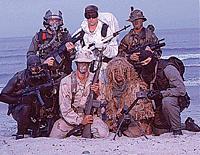

US Navy SEALs (LAND)
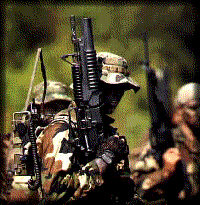
Deep in the tropical rain forest, camouflage-clad men are working their way carefully through the jungle, posting guards as they cross rivers, blending in with the undergrowth as they move silently toward their target.
High on a svnow-covered ridge, sniper team members - all but invisible in their white cold-weather exposure suits - set up their rifles and spotter scopes. They work quickly and carefully, oblivious to the sub-zero temperatures and swirling snow.
On the sun-baked desert floor, a small group of men in desert cammies move carefully among the mesquite and take up positions surrounding their objective. Suddenly, the simmering air erupts with the detonation of a Claymore mine and the heat is made that much more unbearable by the billowing dust.
These three land missions have not been carried out by Green Berets or Rangers or Marines - not by soldiers at all - but by sailors, very special sailors.
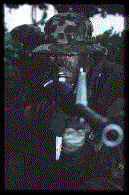 |
We don't block bullets with our bodies. We're human just like the next guy. Just better trained. Anybody with the right motivation and training can do what we do:not! |
Many people think the U.S. Navy SEAL is strictly a combat swimmer and underwater demolition expert. There is a tendency to believe that the SEALs' operational environment is confined either to water or the well-defined perimeter of a beachhead. It is popular to think of the SEAL exclusively as a frogman - a web-footed warrior who carries out daring underwater attacks against enemy shipping and clears beaches and landing sites of enemy obstacles. That image is accurate to a point. But it is just a part of a more comprehensive role played by SEALs in special warfare operations. To classify these highly-trained sailors solely as sea raiders, more at home in the water than out, belies the overall adaptability and versatility of these unique, multifaceted fighting men.
SEALs are certainly experts at water-borne combat missions above or below the surface, but they are also specialists in land warfare operations, especially adept at small-unit infantry tactics. Proficiency in the use of infantry-type combat arms and jungle, desert and mountain tactics are essential elements in their training. This is because SEALs may be called upon to infiltrate well beyond the beaches, deep behind enemy lines, for reconnaissance, surveillance, or intelligence-gathering. And though a mission of this type may begin with an assault from the surface or beneath the sea or a parachute jump from fixed or rotary winged aircraft, once on land, the SEALs transform from frogmen or paratroopers into an elite infantry unit capable of carrying out a high-risk, land-based mission quickly, efficiently and thoroughly.
SEAL land warfare training covers combat weapons familiarization and marksmanship, combat first aid, land navigation, fire movement and maneuvering, patrolling, ambush and counter ambush techniques, river and stream crossings, mountaineering, demolitions, radio field communications, setting up base camps, and preparation of drop and landing zones for helicopter support.
| An instructor from Team Two's training cadre keeps a close eye on a live-fire drill during a simulated casualty extraction. To keep these exercises as realistic as possible, the wounded; wear hidden pouches filled with fake blood and act as if they are actually injured. | 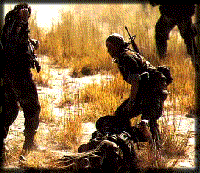 |
The land warfare training has a standard curriculum used by all SEAL teams. Although each team has its own specific mission and area of responsibility, the land tactical warfare curriculum is adaptable to any type of terrain or climate, ranging from heat-seared desert and boulder-strewn mountains to the steaming jungle and bone-chilling Arctic. Teams may add other training that is specifically applicable to their particular mission and the type of terrain in which they will be operating.
SEAL team members are first introduced to land warfare during their training at the Basic Underwater Demolition School at Coronado, Calif. The intent at BUDS is to familiarize the trainee with basic land warfare techniques. It isn't until the BUDS graduate is assigned to an actual SEAL team that these techniques are polished and augmented by additional skills.
This polishing of skills also applies to SEAL veterans who have served with other teams. Upon their transfer from one team to another, they have to learn some of the SOP variations of their new unit. I've been in other teams over a period of fifteen years and there are always new techniques to learn, since each team has its own way of doing things.
The tactical portion of land warfare training is geared to honing those combat skills, which, when used in combination with the proper timing and imagination borne of experience, will ensure a successful mission behind enemy lines. Through unremitting practice and drill, each man builds up his proficiency. With proficiency comes confidence and unerring trust in one's own abilities. But it requires the blending together of the professional skills of each man to make an effective combat unit.
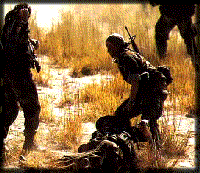 |
Navy SEALs operated behind enemy lines during the Gulf War with such specialized equipment as this dune-buggy. (Actually a very fast and durable weapons platform) |
In tactical training, you are working as infantry on squad levels, with each squad made up of seven or eight men. It involves constant maneuvering with loaded weapons. Thus, safety is emphasized at all times. And although safety is paramount in all phases of SEAL training, it is extremely critical during land warfare training.
The training cadre constantly remind you to treat your weapons as if they were loaded with live ammo at all times. All weapons are kept on safe during troop movements and are not switched to the firing mode until contact is made. Once enemy contact is broken or during maneuvers to break off that contact, weapons are always put back on safe. It is a well known fact of infantry life that men have accidently killed their comrades through disregard of weapons safety.
The land warfare skills are taught in progressive stages. Each particular subject is first introduced in the classroom. In training, there is always the pressure to improve upon everything you've learned and is then followed by practical walk-through or hands-on experience in the field under the watchful eye of the training cadre. Following each walk-through the men are critiqued on their performance and given guidance and suggestions for improvement. Then, when the men feel confident with the evolution, they are allowed to practice the skill as a unit on their own against a simulated enemy force, first without ammo, then with blanks and finally with live rounds.
Although there is constant repetition during training, there is still a low boredom factor. After having spent a particularly long, hot afternoon repeatedly working on a single maneuver, It gets hot, sweaty, dirty and you smell nasty, but I still stay pumped up. When you're in the middle of weapons tactical training and you're 'goin' hot' and everyone is laying down a base of fire, it becomes a real 'rush.' It's so noisy you can't hear yourself talk or scream for that matter ;it's exciting!
The training is a constant process and never lets up. It is intensive. In training, there is always the pressure to improve upon everything you've learned. The pressure to improve your accuracy, timing and teamwork. Our opposition is doing the same thing and that's something you always have to be aware of emphatically that survival is a matter of good training.
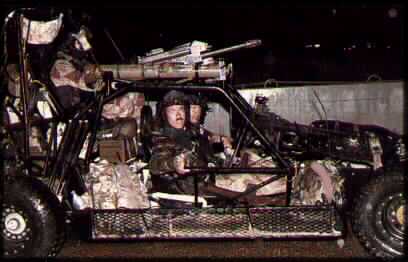
The troops train night and day in every conceivable terrain and every type of weather. Each training evolution, every maneuver, is practiced and rehearsed over and over until it is done right and becomes second nature and can be performed with acrobatic precision. It is a continual, grinding round of patrols, combat maneuvers, immediate action drills and weapons firing. It's learning how to set up a skirmish line and lay down an effective base of fire. It's learning how to get out of an enemy ambush in one piece and setting up a counter-ambush of your own. It's learning how to move through a danger area with just hand signals for communication. It's knowing where to be, when to be there and what to do when you arrive.
But, more importantly, it's learning to work as a team. It is this reciprocal reliance and trust between the individuals that make up the team that provide that all-important cutting edge in combat. It makes the SEALs as formidable on land as they are in the water.